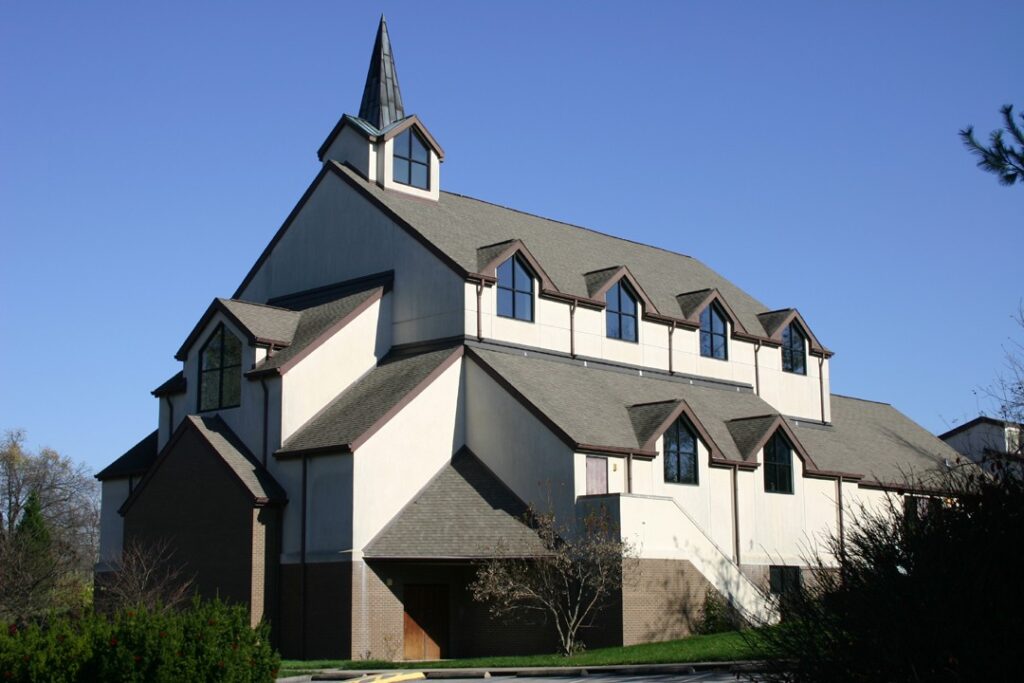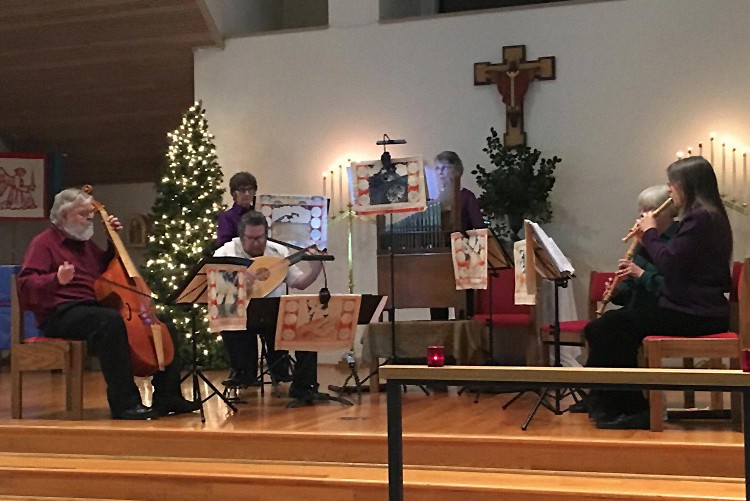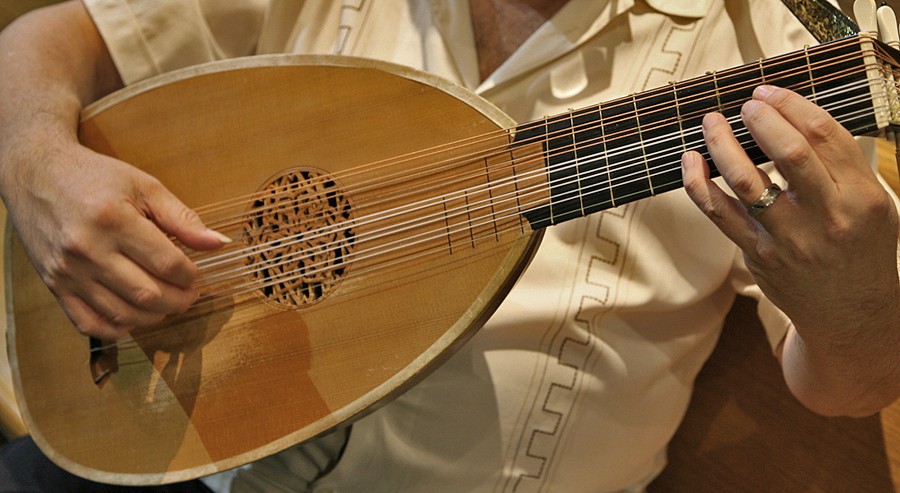In Truman Capote’s short story, “A Christmas Memory,” the young narrator brings to life the true spirit of giving. As he speaks of an elderly distant cousin with whom he lives, he says, “It’s always the same: a morning arrives in November, and my friend, as though officially inaugurating the Christmas time of the year that exhilarates her imagination and fuels the blaze of her heart announces: ‘It’s fruitcake weather!’ ” Each year in a four-day period, she bakes “Thirty-one cakes, dampened with whiskey” to give to friends. “Not necessarily neighbor friends: indeed, the larger share is intended for persons we’ve met maybe once, perhaps not at all . . . these strangers, and merest acquaintances seem to us our truest friends.”
And so it is with The Center for Old Music in the New World when it offers up each year its own seasonal fruitcake, “A Handful of Christmas Delights,” at St. Michael’s Episcopal Church in Lexington, Kentucky. In this modern structure, reminiscent of a small European-style abbey, the acoustics beautifully enhance a remarkable world celebration of traditional and sometimes not-so-traditional tunes, depending on your frame of reference. But there is always a key ingredient or tasty morsel that is sure to sate every holiday appetite.

This season’s selections spanned several hundred years, from the early 13th to late 20th century, and represented seven countries. The strength of this type of programming stems from the fact that it reveals more similarities than differences among peoples throughout the world when it comes to celebrating Christmas. Our connectedness, our oneness. The diverse languages and the musical manners of the day from these various cultures further enriched our appreciation and understanding of these carols that have become an integral part of our lives at this time of year.
Music Director Joanna Manring’s traditional organization of the evening’s program also met seasonal expectations: Exultation—praise to the Virgin Mary; Birth—adoration of the Christ Child; and News, Feasting, and Dancing—joy in the redemption of humankind. Although these program segments are obviously chronological, the music was not, nor did it need to be.
As a tidbit, the audience was first treated to three 13th century instrumental pieces played on rarely-heard period instruments: the krumhorn, the viola da gamba, the lute, the portative organ, the tabor, and recorders. Skillfully performed by Malissa Sullivan (Director of Instrumental), Katherine Bihl, Pat Arnold, John Hedger, Dwight Newton, and Jenny Brock, these works from England, France, and Galicia, respectively, provided a stirring sampler of medieval secular and sacred tunes. A friend in attendance with me commented that these instruments sounded oddly contemporary to her. That perception, however, is not as odd as it may seem if you really think about how many modern-day composers draw on early music such as this for inspiration.

The Exultation, commenced with an affecting choral procession as eighteen acapella voices resounded throughout the ethereal vaults of the sanctuary with a modern arrangement (1990) of a traditional English melody, “Rorate Coeli” (Drop down ye heav’ns from above), sung in Latin but not unfamiliar in English: “For us a child is born / Sing glory be to God.”
[aesop_video width=”70%” align=”center” src=”youtube” id=”jj7RcAFpo80″ loop=”off” autoplay=”off” controls=”off” viewstart=”off” viewend=”off”]
Probably the most moving piece of this segment, though, was from 13th century England (anonymous) sung in Middle English, “Edi be thu, heven-quene” (Blessed be you, heaven’s queen), a polyphonic medieval chant showcasing the women’s chorus in praise of the Virgin Mary. This consummately delivered, other-worldly incantation smoothly transported us to the Birth portion of the program where two better-known Christmas favorites, one instrumental and one choral, were in store.
As John Hedger began playing his arrangement of “Es ist ein Ros’ entsprungen” for solo lute, a stillness blanketed the air to the point that you could almost hear the angels breathe. We know this haunting melody (and song) from 16th-century Germany as “Lo, how a Rose e’er blooming.” And even though there was no vocal component, I was all the more moved as I heard in my mind’s ear the words being articulated by this 13-stringed Renaissance instrument—a clue that it was most assuredly in the hands of a true artist.

Next, the chorus and five soloists graced us with a 1983 arrangement of the ubiquitous English ballad, “The Cherry Tree Carol.” I say ballad because the verse is presented in rhymed couplets which tell the story of Mary announcing to Joseph that she is with child. As the narrative unfolds, Joseph is angered, knowing that the baby is not his, and he refuses to gather the cherries she has asked of him. He realizes his mistake when, at the bidding of the unborn Baby Jesus, the cherry tree bows to the ground so Mary can gather them for herself. Joseph then pleads for forgiveness and asks the baby when its birthday will be. And Jesus replies, “The sixth day of Januar’ My birthday will be, / When the stars in the elements Shall tremble with glee.”
This carol is a yuletide staple for at least three good reasons: First, it is a straight-forward tale that is nothing short of the miracle of the virgin birth itself, the idea of the Holy Child speaking from its mother’s womb. Second, it is a reminder that before we adopted the Gregorian calendar, Jesus’ birthday was celebrated on January 6th, what we now refer to as Old Christmas. Third, it brings to our awareness the idea of celebrating the twelve days of Christmas as a way of slowing down the pace and savoring the quintessential spirit of the season that, as Capote’s narrator suggests, will “exhilarate [our] imaginations and fuel the blaze of [our] hearts.” This is the message, the good news, The Center for Old Music in the New World imparted throughout its program in general and with the last part of the program in particular: News, Feasting, and Dancing.
Following intermission, soloist Camilla Roberson and chorus joined forces in “Noe, Noe! Pastores, Cantate Domino” by French Baroque composer, Guillaume Bouzignac. The piece begins with a quickened tempo in a staccato-like fashion, punctuating the good news, “Noel, noel!” As the voices slowly soften (pianissimo) into incredible resonating harmonies, Roberson bursts forth (sforzando) with her “Gloria” followed by her alternating (and sometime simultaneous) responses to questions posed by the chorus, such as: “Why did God become man? (So that man may see God).” This vocally effective call-and-response type of exchange melded at the end into a single yet harmonious rendering of praise.
The audience was then spirited into an instrumental set of dances from “Terpsichore” by Michael Praetorius (Germany, 1612) that established the tone for the remainder of the performance.
[aesop_video width=”70%” align=”center” src=”youtube” id=”StjD6u1tLG4″ loop=”off” autoplay=”off” controls=”off” viewstart=”off” viewend=”off”]
And by way of continuing the transition from sacred to secular, Jenny Brock and Loren Tice invited us, via a well-balanced duet, to “Make we joye nowe in this fest / In quo Christus natus est.”—to be joyful on this festive occasion in which Christ was born.
Ending not only on a high note (figuratively speaking), but also on a highly personalized note (literally speaking), the singers indulged the audience in an all-time holiday favorite, “Wassail Song,” with its sweet refrain: “Love and joy come to you, and to you your wassail too, / And God bless you, and send you a happy new year.” Then Manring stepped down from the podium and joined the troupe for the final treat that took the cake, “Lexington Wassail,” a customized version of the traditional English “Apple Tree Wassail.”
When I asked one of the singers how Lexington became a part of the title of this song, he replied rather jokingly, “We call it the ‘Lexington Wassail’ because we’ve been singing it in Lexington, Kentucky longer than any musicologist can prove it was ever sung in jolly old England!” As individual singers contributed a customized verse, the audience was invited to join in on the familiar refrain. And the verse that wrapped up the evening went something like this: “Here’s a toast to our neighbors and long may you live / since you’ve been so kind and so willing to give / We’re glad you’re not selfish, pernicious or mean / so live to the fullest in Two Thousand Seventeen!”
In the manner of Truman Capote’s “A Christmas Memory,” this was an invitation to friendship with “strangers, and merest acquaintances,” or perhaps persons we have never met. After all, “It’s fruitcake weather!” And the amount of time that it takes a fruitcake, “dampened with whiskey” nonetheless, to ripen or mellow so that it melts in your mouth is equally true of the joyous music presented to us at Christmas time. Hence, the baking and rehearsing must always begin in November, if not sooner. The Center for Old Music in the New World’s “A Handful of Christmas Delights” was delicious!
So if you missed this season’s performance, then you have next Christmas to look forward to. And although the program has not yet been determined, Director Joanna Manring indicated that the Company’s spring concert will be of equal delight, addressing themes of rebirth, awakening, and renewal as the cycle of life continues.
All performances are free (donations suggested). What a gift! For announcements and updates, keep a lookout at http://www.centerforoldmusic.org. And happy New Year good friends, known and unknown!
Note: Video clips courtesy of The Center for Old Music in the New World and Steve Davis




